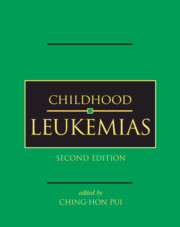Book contents
- Frontmatter
- Contents
- List of contributors
- Preface
- Part I History and general issues
- Part II Cell biology and pathobiology
- Part III Evaluation and treatment
- Part IV Complications and supportive care
- 29 Acute complications
- 30 Late complications after leukemia therapy
- 31 Therapy-related leukemias
- 32 Infectious disease complications in leukemia
- 33 Hematologic supportive care
- 34 Pain management
- 35 Psychosocial issues
- 36 Nursing care
- Index
- Plate Section between pages 400 and 401
- References
29 - Acute complications
from Part IV - Complications and supportive care
Published online by Cambridge University Press: 01 July 2010
- Frontmatter
- Contents
- List of contributors
- Preface
- Part I History and general issues
- Part II Cell biology and pathobiology
- Part III Evaluation and treatment
- Part IV Complications and supportive care
- 29 Acute complications
- 30 Late complications after leukemia therapy
- 31 Therapy-related leukemias
- 32 Infectious disease complications in leukemia
- 33 Hematologic supportive care
- 34 Pain management
- 35 Psychosocial issues
- 36 Nursing care
- Index
- Plate Section between pages 400 and 401
- References
Summary
Introduction
The most common cause of early treatment failure among patients with childhood leukemia is death due to acute complications of the leukemia itself or its initial treatment. Despite the increasing intensity of treatment for acute lymphoblastic leukemia (ALL) in children, improvements in supportive care have reduced the rate of death due to acute complications from 10% in the early 1970s to less than 2% in the 1990s, and these improvements have had an important impact on event-free survival estimates for these patients. In fact, studies of the Medical Research Council (MRC) found that the rate of treatment-related death among children with ALL decreased from 9% in the 1980s (UKALL VIII trial) to 2% in the 1990s (UKALL X and XI trials). Hence, the 6% improvement in the 5-year event-free survival estimate during the same period (from 55% to 61%) can be attributed largely to advances in supportive care. The rate of toxic death associated with therapy for acute myeloid leukemia (AML) and relapsed ALL has also decreased over time but remains unacceptably high at 10% or greater in many studies. In countries with limited resources, death from toxicity accounts for more cases of treatment failure than does relapse in both AML and ALL.
Acute complications include “early” complications (those occurring within the first 2 weeks of therapy) and “on-therapy” complications (those occurring after the first 2 weeks of therapy). “Late” complications are those occurring after recovery from the final dose of chemotherapy (Table 29.1).
Information
- Type
- Chapter
- Information
- Childhood Leukemias , pp. 709 - 749Publisher: Cambridge University PressPrint publication year: 2006
References
Accessibility standard: Unknown
Why this information is here
This section outlines the accessibility features of this content - including support for screen readers, full keyboard navigation and high-contrast display options. This may not be relevant for you.Accessibility Information
- 7
- Cited by
